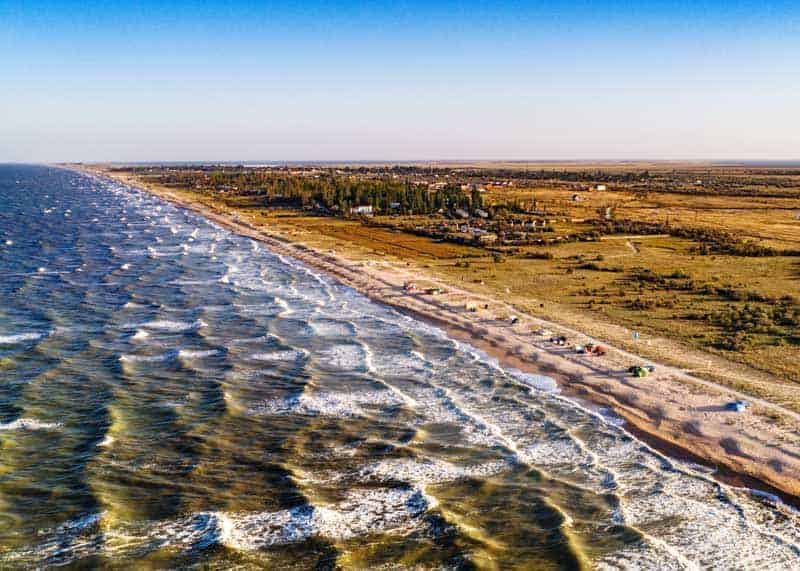The drone industry has a unique set of vocabulary and lingo. If you’re just getting started, drone terminology can be a little confusing. There are at least 9 other names for drones. Plus we include the common lingo and slang.

Complete Drone Glossary: 63 Terms
Here is your guide to the sometimes confusing drone vocabulary and acronyms. You’ll learn about important drone terms, synonyms for drones, drone acronyms, and aviation terms in the United States and Canada.
And this guide is a work in progress. As I learn and receive suggestions, I’ll be updating the post. Have a term to add? Let me know in the comments!
9 Other Names for Drones
There are two technical names for drones. They both mean the same thing but are decided primarily by geography.
- RPAS: Remotely Piloted Aircraft System. This is a broad term adopted by many international aviation organizations. They include the International Civil Aviation Organization (ICAO) and aviation authorities from Australia, New Zealand, Canada, and much of Europe.
- UAS:Unmanned Aircraft System. This term has been used by aviation authorities in the USA (FAA) and UK (CAA). Also, it is used by the US-based AUVSI (Association for Unmanned Vehicle Systems International). And the EASA (European Union Aviation Safety Agency) uses the terms UAS and drones interchangeably.
- sUAS: Small Unmanned Aircraft System. This is a subcategory of UAVs, typically under 55 lbs (25 kg) in weight. The “s” is written in lowercase.
What other names do drones have? Here are seven other names for drones:
- MAV: Micro Air Vehicle, Micro Aerial Vehicle. In the United States, this refers to drones weighing less than 55 lbs. (25 kg). Learn more (link opens PDF).
- Microdrone: In Canada, this refers to drones that weigh less than 250 grams.
- Quadcopter: This name is specific to aircraft with just 4 rotors. Small drones, like DJI Air 2S, are quadcopters. Larger drones can have 6 or 8 rotors (known as hexacopter or octocopter).
- RPA: Remotely Piloted Aircraft. This is an accurate term but seldom used. Most agencies and pilots prefer RPAS – probably because a longer acronym is less confusing. The RPA acronym is more commonly used in robotics (robotic process automation) which doesn’t have anything to do with aerial vehicles.
- UA: Unmanned Aircraft. This is a blanket term and is seldom used because it is too broad.
- UAV: Unmanned Aerial Vehicle. This has become somewhat of an informal term for UAS. Online, RPAS are often referred to as drones or UAV. But this acronym isn’t commonly used by aviation authorities or agencies.
- UAVS: Unmanned Aerial Vehicle System. Similar to UAV, this is somewhat of a slang reference to UAS.
What Drones are Known As Around the World
While drones are popular globally, unfortunately we haven’t been able to agree on what to call them.
Here are the four most common terms, and the parts of the world that uses them the most.
- UAS: United States and United Kingdom. This term was adopted by US Department of Defense and US FAA in 2005.
- RPAS: Canada, Australia, New Zealand, and much of Europe. The European Defence Agency (EDA) prefers this term.
- Drone: France. The French Civil Aviation Authority (DGAC) uses two terms: drones and remote-controlled aircraft (aéronefs télépilotés). It’s worth noting that France uses the word “drone” as a loanword, not a translated word.
- UAV and Drone: Online. It seems that because of the lack of continuity between countries and regions, the internet has settled on these two informal terms. They are used interchangeably and are used online to refer to recreational and prosumer level drones.
Origin of the Word: Drone
drone (n.) male honeybee, from Middle English drane, drone. In the 1520s, the word meant lazy worker (because make bees don’t make honey).
Similar words exist in Dutch, German, Lithuanian, and Greek.
What does UAV stand for?
UAV stands for unmanned aerial vehicle. This is an umbrella term for autonomous aircraft. That is, a drone that navigates without a human pilot onboard.
7 UAV Acronyms
What does UAV stand for? Here are seven options, that all refer to autonomous drones.
- Unmanned Aerial Vehicle (Most Common)
- Unmanned Air Vehicle (Common)
- Unmanned Aircraft Vehicle (Common)
- Unmanned Aerospace Vehicle
- Unmanned Airborne Vehicle
- Uninhabited Aircraft Vehicle
- Unmanned Autonomous Vehicle
The uses of these terms vary depending on country and application of the unit.
Flight Terms and Lingo
- AGL: Above Ground Level. This measures the actual altitude between the ground and your drone.
- ATC: Air Traffic Control.
- BVLOS: Beyond visual line of sight.
- Bystander: Anyone who isn’t directly associated with the drone operation.
- Flight crew: Everyone working directly with the drone operation.
- FOV: Field of View: What the drone sees from the camera.
- FPV: First Person View This is a method of flying a drone. Most commonly, FPV drones transmit video feed to goggles or a headset, although it can also transmit to a mobile device or another display. Also known as remote-person view (RPV) or video piloting. For a glimpse of what this looks like, check out the DJI FPV drone.
- LiPo: Lithium Polymer Batteries. This is the most common type of power source for drones. More about LiPo battery storage.
- NOTAM: Notice to Airmen. This is a warning of potential hazards filed with an aviation authority. Hazards included in NOTAMs can include air shows, closed runways, miliary exercises, passage of flocks of birds (BIRDTAM).
- Pitch: The drones rotation, when the nose rotates up or down in relation to the horizontal plane.
- Roll: To move the drone laterally, from side to side.
- VLOS: Visual-line-of-sight.
Drone Terms and Features
- Accelerometer: Measures the drones orientation relative to earths surface. It monitors the 3D acceleration force on all 3 axis (X, Y, and Z). This provides speed, direction, and altitude change of the drone.
- Obstacle Avoidance: This sensor-based feature is on most higher-end drones. Some lower-cost drones, like the DJI Mini 2, have only basic avoidance sensors.
- Payload: This can include cameras, lights, landing gear, proper guards.
- RTF: Ready to Fly. An RTF drone comes ready to fly from the manufacturer. Most consumer and prosumer drones are RTF.
- RTH: Return to Home. This feature will bring your drone back to its preset home point, usually your point of take off. This is an important feature to watch for. And to make sure it’s set before take off.
- Headless Mode: A setting that orients your drone to you (as the controller) instead of to the direction that the drone is actually facing. Typically a beginner feature. Learn more about headless mode.
Drone Flight Modes
- Drone Modes. Here aee the standard flight modes for DJI drones.
- A-Mode: Attitude Mode or ATTI Mode. Your drone maintains a set altitude, but not position. You can still navigate horizontally, but not vertically.
- P-Mode: This is the standard flight mode. It makes use of all sensors, including GPS and all vision sensors. This not only helps safer flight (obstacle avoidance) but it also make it more stable hovering and precise flight.
- S-Mode: Sport Mode. This mode allows your drone to fly faster. Most sensors are turned off, with the exception of GPS.
It’s important to note that none of these terms and modes relate to the onboard camera. We’ll cover drone camera settings in a future post.
Canadian Drone Terms (Transport Canada)
Canadian drone laws are distinct from other countries.
- Basic Operations Certificate: Certificate issued by Transport Canada, after taking a written exam. Required for piloting drones that weigh 250 grams to 25 kg. Here’s what you need to know to take the exam.
- Advanced Operations Certificate: This is also issued by Transport Canada and requires both a multiple-choice exam and an in-person flight review.
- Flight Log / Maintenance Log: Record both your flight details and your maintenance/ repair history of your drone. Required for drone pilot certificate holders.
- Foreign Operator: Foreign operators include everyone who isn’t a Canadian citizen, permanent resident, or provincial or federally incorporated corporation. Read more from Transport Canada.
- PIPEDA (Personal Information Protection and Electronic Documents Act). Canadian legislation that oversees data collection, storage, and distribution.
- Recency Requirement: Requirement to refresh drone laws and requirements every 24 months. Here is a free self study program by Transport Canada.
- SFOC: Special Flight Operations Certificate is issued by Transport Canada and allows drone operations usually excluded by standard rules.
Here’s more about drone laws in Canada.
United States Drone Terms (FAA)
- Part 107: Regulations from FAA for drone operators. To receive their Part 107 pilot license, they must pass a test that covers FAA regulations and procedures for safe operation.
- COA: Certificate of Authorization. This FAA (Federal Aviation Administration) permit allows drone operator to perform additional, specific operations.
More reading: Guide to GoPro Drones

More reading: The Best Drone Insurance in Canada
If you’re shooting in 4K (or higher resolution), you should learn what HEVC video is.
Your Turn
Have a question about some of the drone terminology? Maybe a suggestion for one to add? Let me know below!
- About the Author
- Latest Posts
Hey, I’m Bryan! I’m a content creator and co-founder of Storyteller Tech.
Experienced GoPro Videographer: I’ve been shooting with GoPro cameras for over 11 years. My first GoPro was the Hero3 Silver, bought for a Galapagos work trip in 2012. Today I own 20+ action cameras, including GoPro, DJI, and Insta360 cameras.
Professional Creator: Dena and I have developed video and content marketing plans for numerous international travel brands. And we also run several content businesses.
Bryan also creates at Storyteller.Travel and is co-founder of Storyteller Media, a Canadian-based publishing company.

Ron Clifford
Tuesday 5th of July 2022
I was hoping to see more of the terms listed in the sales info such as 4k cameras and so forth in a little more depth. The rest in this article was great, every bit helps.
Bryan Haines
Wednesday 6th of July 2022
Thanks Ron, we'll cover those details in a future guide.